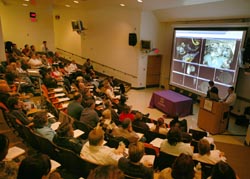Streaming Synapses

Follow us
Add us as a preferred source on Google
- The University of Buffalo's Neurosurgery Department is now able to stream live surgeries around the world, allowing viewers to communicate with the doctors in real time. BUFFALO, NY-IPLogic was recently brought into the University at Buffalo's Neurosurgery Department to put together an intricate system to connect its students with doctors around the world. The university was looking for a permanent solution to increase the frequency of its global broadcasts, which were becoming increasingly costly to perform with.
- Peter Grosskopf, manager of IPLogic's AV group, was brought into the job based on an existing relationship from a phone system the company had previously installed. Grosskopf explained, "It was brought up that the university hosts these satellite uplinks of surgery to a convention of neurosurgeons around the world. It's a really big deal to the doctors. Our sales guy told them about my history as a broadcaster--I'm a broadcast engineer for the NHL and NFL on the side. So we discussed what we could put together. The director of technical operations for the neurosurgery suite wanted to own the broadcasting technical abilities. He wanted the camera and all the images, and he also wanted to be able to do these broadcasts on a daily basis."
- IPLogic put together a system that would allow the university to do just that, as Grosskopf recalled. "We designed a system with a giant Extron 48 x 48 composite video router, 16 x 16 VGA router, 8 x 8 audio router, and we controlled it with a Crestron control system. We also had IFB wireless audio with Sennheiser gear, all using Shure and Countryman headset mics with Sennheiser transmitter packs."
- The most complex part of the system is how the director is able to control the feeds of the system, as Grosskopf said. "From the director's office, he can manipulate the feeds through his web browser. He can send them from the surgery room to the truck bay, where they can back up a truck to an IP video server. Then we added a separate Crestron unit in a viewing room, where they have a giant 8 x 4 foot window looking over the surgery suite and they can bring in students and guests. Viewers can hear the doctor talking, and through the Crestron AV2 they can select any brain scan image the doctors are looking at. They are imported to the Crestron screen, and you can send those to any of the three LCD monitors that are mounted above the window. It's really interactive for students--the doctor can conduct the surgery and have 15 people in the room and not have them interfere in the surgery or control room operations."
- Grosskopf's team also installed a Crestron unit in the university's auditorium. "We put in small MPS100 Crestron unit there. We put a new Hitachi projector and a 10-foot Da-Lite screen in as well. The director can enter his password in the MPS100 and he can get access to the Crestron unit and router upstairs in the surgery suite. So now he can start sending video down to the auditorium too, as well as the brain images, and they can host 150 people. We put Countryman and Sennheiser mics in the auditorium for questions so students downstairs can talk directly to the doctor upstairs in real time. Through the IP video server and the satellite uplink, the university can still do broadcasts to convention sites to Beijing and Paris, or wherever they want the feed to go. Up to 15,000 doctors can have access to these surgeries. The doctors can hear people asking them questions in different countries as they perform surgery."
- The system has been so successful, not only has the university installed another angioplasty suite, but they've encouraged IPLogic to put together a package to sell to other universities. "Through support from UB Neurosurgery, we want to package this deal," Grosskopf noted. "They want us to push this to other hospitals and get doctors involved with this type of teaching."
scn Newsletter
A daily selection of the top stories for AV integrators, resellers and consultants. Sign up below.
TOPICS
